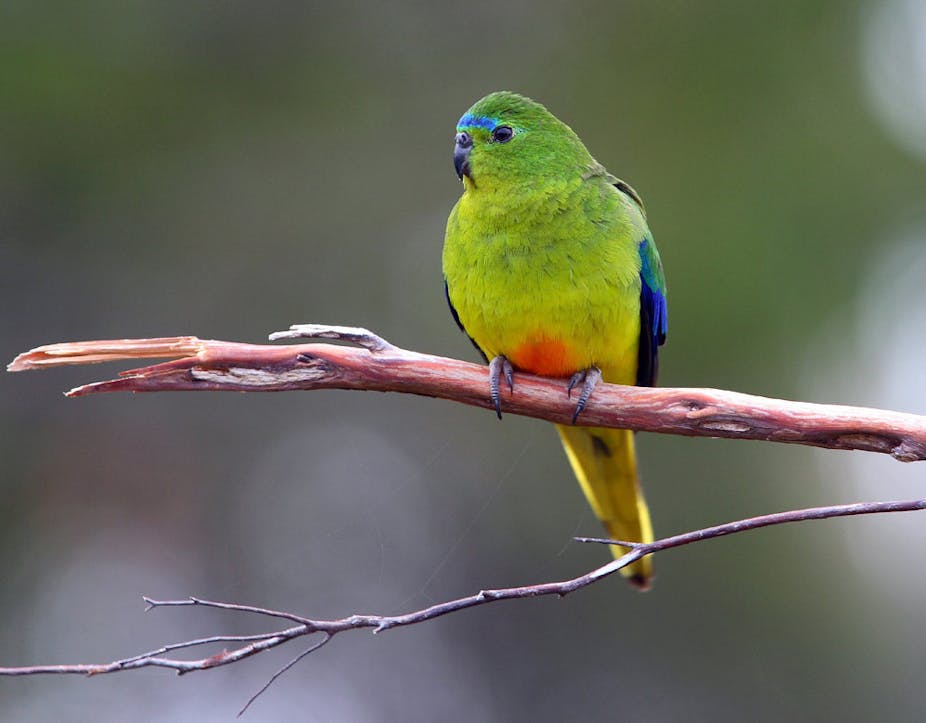You might have concluded that Australia’s critically endangered Orange-bellied Parrot is heading the way of the dodo, after recent media reports revealed an outbreak of Psittacine Beak and Feather Disease.
There are fewer than 50 parrots left in the wild. Most of this year’s tiny crop of parrot nestlings at Melaleuca in southwest Tasmania – the only place where the parrot breeds – have been infected with the usually fatal disease.
So is this the end for the Orange-bellied Parrot?
Insurance population
In the short term the answer is no. Four years ago the Orange-bellied Parrot’s recovery team agreed to the extraordinary step of capturing wild birds to boost the genetic viability of the existing captive population. The carefully managed population of captive parrots is now spread among ten captive facilities and numbers over 340 individuals.
So, at the very least, the Orange-bellied Parrot could become the first Australian species to be listed as “Extinct in the Wild”, joining five other bird species worldwide. And, as with each of these, reintroduction would remain the long-term intention, although likely to be extremely difficult once there are no wild birds to guide behaviour.
In the meantime, for the existing wild population, the immediate future does look grim and some very difficult decisions will need to be made this week when the Threatened Species Commissioner, Gregory Andrews, chairs a meeting on the future of the species. There are several options available.
Time to give up?
The first option could be to give up. Should the effort to save the species in the wild be abandoned as too expensive with too little prospect of success? For example would it be better if the funds were diverted to another threatened Tasmanian parrot, the Swift Parrot, also desperately threatened but with better prospects of recovery?
While a minister for the environment in an elected government has a democratic mandate to permit a preventable extinction, the strong emphasis given to threatened species by Greg Hunt makes this option seem unlikely.
Neither would it have been supported by the electorate, nearly all of whom want no further extinctions to occur. The trouble with “allowing” a preventable extinction is that there is no logical point at which extinction should never be permitted.
So what can be done? The Commissioner, who worked with the Minister to mobilise the funds, is initially intending to canvass four ideas: to review the “out of date” threat abatement plan for the disease, to boost the parrot’s captive breeding, screen for beak and feather disease and adjust captive management to reduce spread of the disease.
The Department was in the process of revising its 2005 Psittacine Beak and Feather Threat Abatement Plan, ironically sporting a picture of the Orange-bellied Parrot on its cover, when news on the latest outbreak arrived last week. The plan acknowledges that the disease is unlikely to be completely eradicated as it is native to Australia, has many different forms, can be transmitted from a female to its egg and some species, particularly lorikeets, can recover from infection and then shed the virus for other parrots to catch.
Living with disease
So threat abatement is about helping parrot populations live with the disease while ensuring it does not cause extinction. When the plan was reviewed in 2012 about half of its actions had been achieved but a promising vaccine had not been trialled for lack of funds and screening procedures had not been adopted generally because they were too expensive.
Both screening and a vaccine would help, particularly in managing captive populations which are then used to augment the wild birds.
They are also key to increasing the number that can be released to the wild, though that may be a longer-term ambition – releases should not compromise the already tenuous viability of the captive insurance population.
Eventually, however, the release of larger numbers each year is the best strategy for re-establishing a self-sustaining wild population if the root cause of the original decline can be determined.
But perhaps it is the word “hope” that is the most important ingredient for success. The species has been struggling for so long and has already absorbed so much conservation money, that at least some people have lost hope for it. What the Threatened Species Commissioner can most usefully bring to the meeting may not be money, though that will be needed, but an optimism that a way forward is possible.
Helping other species
A big mistake would be to see any of the actions the Commissioner proposes as benefiting the parrot alone. The disease affects all parrots so that a more effective plan will potentially benefit many species. Protocols developed for the Orange-bellied Parrot will make conservation of those other species much less expensive when they too are affected by the disease, as is highly likely.
Vaccines, screening procedures and improved husbandry techniques are also investments. Indeed they could generate financial returns if handled appropriately. New Zealand has successfully exported its pest-eradication services globally after trialling and refining techniques on its own rat-infested islands.
Australia, as the source of Parrot Beak and Feather Disease, could also export skills in managing it and other infectious diseases in captive populations. The global popularity of parrots as cage birds ensures there is a substantial commercial market for such skills if they are developed with that objective in mind.
Some of the captive populations of Orange-bellied Parrots are already held in private facilities. There would seem to be substantial potential to expand such public-private partnerships to help not just Orange-bellied Parrots but conservation more generally.
Orange-bellied Parrots are a challenging species to conserve. Challenges can generate innovations with benefits far beyond their target. The best outcome would be for the parrot to become a flagship for conservation innovation rather than of prospective failure.

